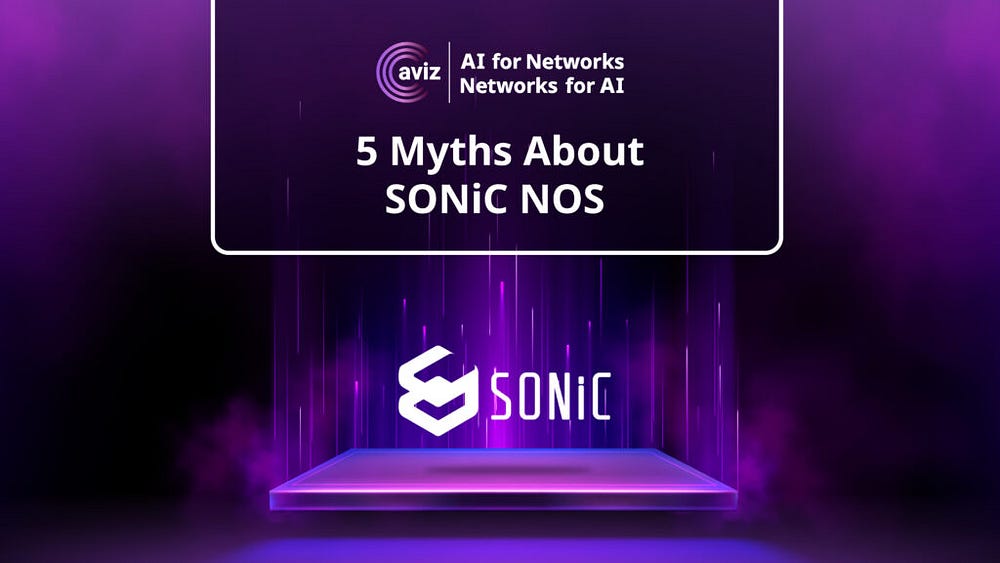5 Myths About SONiC NOS

The rise of SONiC (Software for Open Networking in the Cloud) has disrupted the traditional networking industry, offering enterprises a vendor-agnostic, open-source alternative to proprietary NOS solutions. But with disruption comes misconceptions, and SONiC is no exception.
Let’s debunk the top five myths about SONiC NOS and set the record straight.
Myth #1: SONiC is Only for Hyperscalers
Reality: SONiC is Ready for Enterprises, AI Workloads, and Beyond
While hyperscalers like Microsoft pioneered SONiC, it’s no longer just for the tech giants. Enterprises across healthcare, retail, finance, and AI-driven data centers are deploying SONiC to cut costs, increase flexibility, and escape vendor lock-in.
👉 2025 PlugFest validated SONiC for enterprise-grade use cases, including Layer 2 networking, AI fabric, and PoE-enabled whitebox switches — proving its viability beyond hyperscalers.
Want to hear real-world enterprise SONiC success stories?
Join us for a compelling SDxCentral panel discussion featuring insights from our customers, Techevolution and 1984, alongside our partner, EPS Global. Explore how SONiC is transforming enterprise networking with unparalleled flexibility and efficiency.
Myth #2: SONiC is Difficult to Deploy
Reality: SONiC Adoption is Faster and Easier Than Ever
There’s a misconception that SONiC requires deep coding skills or hyperscaler-level engineering resources. That was true in its early days, but today, we have 1-click SONiC fabric deployment and enterprise-ready SONiC solutions come with automation, APIs, and user-friendly management tools.
💡 One-click SONiC migration guides and vendor support services have made the transition seamless — offering enterprises the same ease of deployment as traditional NOS solutions.
Myth #3: SONiC Lacks Vendor Support
Reality: A Thriving Ecosystem Backs SONiC
Some believe that using an open-source NOS means you’re on your own. That couldn’t be further from the truth. The SONiC ecosystem includes major vendors like Cisco, NVIDIA, Celestica, Edgecore, and Wistron, offering hardware compatibility, support services, and enterprise-ready integrations.
Aviz Networks is actively enabling SONiC interoperability and provide full-stack support, automation, and performance optimizations — ensuring enterprises get the help they need.
Myth #4: SONiC is Not Cost-Effective
Reality: SONiC Delivers Up to 40% TCO Savings
Proprietary NOS vendors often claim that SONiC isn’t cost-effective when factoring in hardware, support, and integration costs. But PlugFest’s TCO analysis tells a different story:
- Up to 40% lower TCO compared to proprietary NOS solutions
- No NOS licensing costs — reducing OpEx significantly
- Multi-vendor flexibility eliminates hardware markups and vendor lock-in
💰 Bottom line? SONiC saves enterprises millions while providing scalability for AI-driven workloads.
Myth #5: SONiC is Just a Trend — It Won’t Last
Reality: SONiC is the Future of Open Networking
Some skeptics believe SONiC is just another open-source experiment that will fade away. The reality? SONiC adoption is accelerating, with major enterprises, cloud providers, and AI data centers making it their NOS of choice.
With strong backing from industry leaders, ongoing community development, and real-world deployments, SONiC is shaping the future of open networking, AI infrastructure, and multi-vendor interoperability.
The Verdict: SONiC is Ready for Prime Time
SONiC NOS has matured beyond its hyperscaler origins into a battle-tested, cost-efficient, and enterprise-ready solution. As the 2025 PlugFest demonstrated, the myths surrounding SONiC are outdated, and the reality is clear:
- Enterprise adoption is growing
- Deployment is easier than ever
- strong vendor ecosystem is supporting SONiC
- TCO savings make it a smarter investment
- Open networking is the future, and SONiC is leading the way
FAQ’s
1. Is SONiC NOS only meant for hyperscalers like Microsoft or Google?
A. No. While SONiC originated with hyperscalers, it is now widely adopted by enterprises across industries — including healthcare, retail, finance, and AI-driven data centers — for its flexibility, open-source benefits, and vendor-agnostic architecture.
2. How difficult is it to deploy SONiC in an enterprise environment?
A. SONiC deployment is now simplified with one-click fabric orchestration, migration guides, intuitive GUI tools, and vendor-supported solutions — making it as easy as traditional network operating systems for enterprises to adopt.
3. Does SONiC come with vendor support and integration help?
A. Yes. SONiC is backed by a growing ecosystem of top vendors like NVIDIA, Cisco, Edgecore, and Celestica. Additionally, companies like Aviz Networks offer full-stack SONiC support, automation tools, and deployment services tailored for enterprise use.
4. Is SONiC more cost-effective than proprietary NOS solutions?
A. Absolutely. SONiC can deliver up to 40% lower total cost of ownership (TCO) by eliminating NOS licensing fees, offering multi-vendor hardware flexibility, and reducing OpEx through automation and open-source efficiencies.
5. Will SONiC last, or is it just a passing trend in networking?
A. SONiC is here to stay. Backed by major industry players and community contributions, SONiC has evolved into a mainstream open networking platform with real-world deployments in AI fabrics, enterprise data centers, and multi-vendor environments.

.png)
Comments
Post a Comment